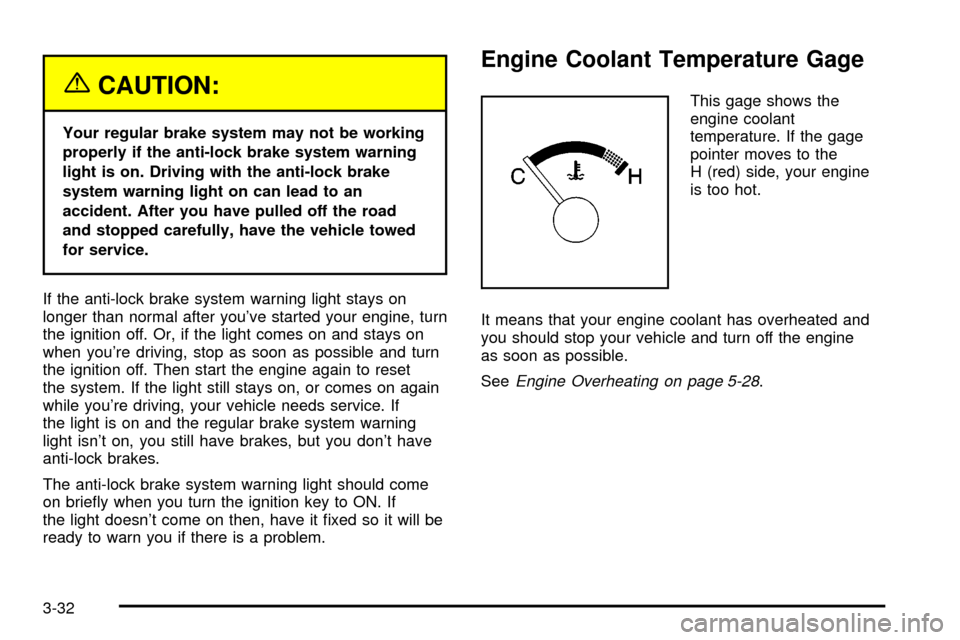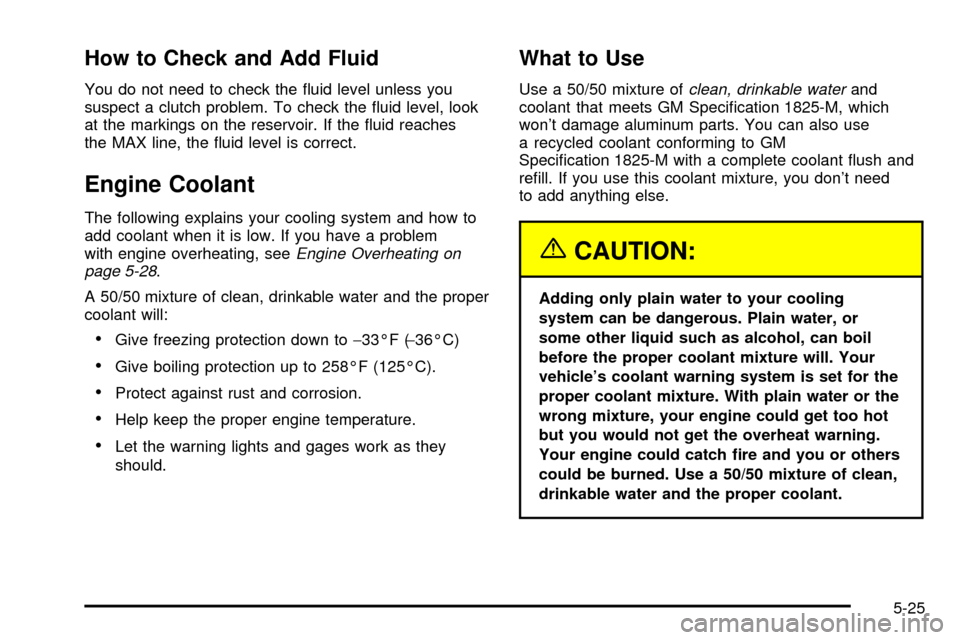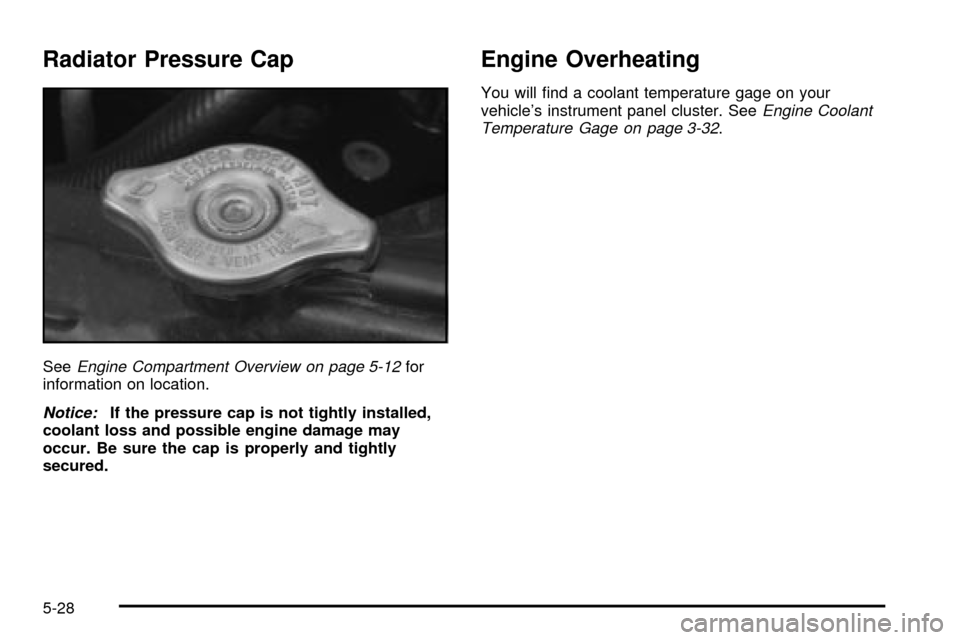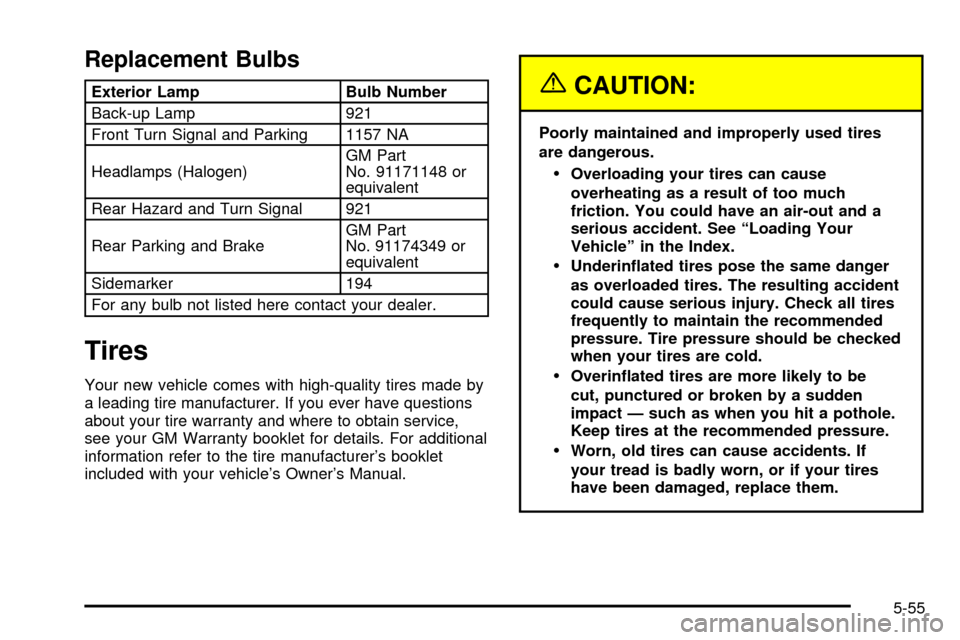overheating CHEVROLET TRACKER 2004 2.G Owners Manual
[x] Cancel search | Manufacturer: CHEVROLET, Model Year: 2004, Model line: TRACKER, Model: CHEVROLET TRACKER 2004 2.GPages: 374, PDF Size: 2.57 MB
Page 134 of 374

{CAUTION:
Your regular brake system may not be working
properly if the anti-lock brake system warning
light is on. Driving with the anti-lock brake
system warning light on can lead to an
accident. After you have pulled off the road
and stopped carefully, have the vehicle towed
for service.
If the anti-lock brake system warning light stays on
longer than normal after you've started your engine, turn
the ignition off. Or, if the light comes on and stays on
when you're driving, stop as soon as possible and turn
the ignition off. Then start the engine again to reset
the system. If the light still stays on, or comes on again
while you're driving, your vehicle needs service. If
the light is on and the regular brake system warning
light isn't on, you still have brakes, but you don't have
anti-lock brakes.
The anti-lock brake system warning light should come
on brie¯y when you turn the ignition key to ON. If
the light doesn't come on then, have it ®xed so it will be
ready to warn you if there is a problem.
Engine Coolant Temperature Gage
This gage shows the
engine coolant
temperature. If the gage
pointer moves to the
H (red) side, your engine
is too hot.
It means that your engine coolant has overheated and
you should stop your vehicle and turn off the engine
as soon as possible.
See
Engine Overheating on page 5-28.
3-32
Page 213 of 374

Service............................................................5-3
Doing Your Own Service Work.........................5-3
Adding Equipment to the Outside of Your
Vehicle......................................................5-4
Fuel................................................................5-4
Gasoline Octane............................................5-4
Gasoline Speci®cations....................................5-4
California Fuel...............................................5-5
Additives.......................................................5-6
Fuels in Foreign Countries...............................5-6
Filling Your Tank............................................5-7
Filling a Portable Fuel Container.......................5-9
Checking Things Under the Hood....................5-10
Hood Release..............................................5-10
Engine Compartment Overview.......................5-12
Engine Oil...................................................5-13
Engine Air Cleaner/Filter................................5-18
Automatic Transmission Fluid.........................5-20
Manual Transmission Fluid.............................5-23
Hydraulic Clutch...........................................5-24
Engine Coolant.............................................5-25
Radiator Pressure Cap..................................5-28
Engine Overheating.......................................5-28
Cooling System............................................5-31
Power Steering Fluid.....................................5-37Windshield Washer Fluid................................5-37
Brakes........................................................5-39
Battery........................................................5-42
Jump Starting...............................................5-43
Rear Axle.......................................................5-48
Four-Wheel Drive............................................5-49
Bulb Replacement..........................................5-51
Halogen Bulbs..............................................5-51
Headlamps..................................................5-51
Front Turn Signal and Parking Lamps..............5-53
Sidemarker Lamps........................................5-53
Rear Combination Lamps...............................5-54
Replacement Bulbs.......................................5-55
Tires..............................................................5-55
In¯ation - Tire Pressure.................................5-63
Tire Inspection and Rotation...........................5-64
When It Is Time for New Tires.......................5-66
Buying New Tires.........................................5-67
Uniform Tire Quality Grading..........................5-68
Wheel Alignment and Tire Balance..................5-69
Wheel Replacement......................................5-70
Tire Chains..................................................5-71
If a Tire Goes Flat........................................5-72
Changing a Flat Tire.....................................5-72
Section 5 Service and Appearance Care
5-1
Page 237 of 374

How to Check and Add Fluid
You do not need to check the ¯uid level unless you
suspect a clutch problem. To check the ¯uid level, look
at the markings on the reservoir. If the ¯uid reaches
the MAX line, the ¯uid level is correct.
Engine Coolant
The following explains your cooling system and how to
add coolant when it is low. If you have a problem
with engine overheating, see
Engine Overheating on
page 5-28.
A 50/50 mixture of clean, drinkable water and the proper
coolant will:
·Give freezing protection down to-33ÉF (-36ÉC)
·Give boiling protection up to 258ÉF (125ÉC).
·Protect against rust and corrosion.
·Help keep the proper engine temperature.
·Let the warning lights and gages work as they
should.
What to Use
Use a 50/50 mixture ofclean, drinkable waterand
coolant that meets GM Speci®cation 1825-M, which
won't damage aluminum parts. You can also use
a recycled coolant conforming to GM
Speci®cation 1825-M with a complete coolant ¯ush and
re®ll. If you use this coolant mixture, you don't need
to add anything else.
{CAUTION:
Adding only plain water to your cooling
system can be dangerous. Plain water, or
some other liquid such as alcohol, can boil
before the proper coolant mixture will. Your
vehicle's coolant warning system is set for the
proper coolant mixture. With plain water or the
wrong mixture, your engine could get too hot
but you would not get the overheat warning.
Your engine could catch ®re and you or others
could be burned. Use a 50/50 mixture of clean,
drinkable water and the proper coolant.
5-25
Page 240 of 374

Radiator Pressure Cap
SeeEngine Compartment Overview on page 5-12for
information on location.
Notice:If the pressure cap is not tightly installed,
coolant loss and possible engine damage may
occur. Be sure the cap is properly and tightly
secured.
Engine Overheating
You will ®nd a coolant temperature gage on your
vehicle's instrument panel cluster. SeeEngine Coolant
Temperature Gage on page 3-32.
5-28
Page 267 of 374

Replacement Bulbs
Exterior Lamp Bulb Number
Back-up Lamp 921
Front Turn Signal and Parking 1157 NA
Headlamps (Halogen)GM Part
No. 91171148 or
equivalent
Rear Hazard and Turn Signal 921
Rear Parking and BrakeGM Part
No. 91174349 or
equivalent
Sidemarker 194
For any bulb not listed here contact your dealer.
Tires
Your new vehicle comes with high-quality tires made by
a leading tire manufacturer. If you ever have questions
about your tire warranty and where to obtain service,
see your GM Warranty booklet for details. For additional
information refer to the tire manufacturer's booklet
included with your vehicle's Owner's Manual.
{CAUTION:
Poorly maintained and improperly used tires
are dangerous.
·Overloading your tires can cause
overheating as a result of too much
friction. You could have an air-out and a
serious accident. See ªLoading Your
Vehicleº in the Index.
·Underin¯ated tires pose the same danger
as overloaded tires. The resulting accident
could cause serious injury. Check all tires
frequently to maintain the recommended
pressure. Tire pressure should be checked
when your tires are cold.
·Overin¯ated tires are more likely to be
cut, punctured or broken by a sudden
impact Ð such as when you hit a pothole.
Keep tires at the recommended pressure.
·Worn, old tires can cause accidents. If
your tread is badly worn, or if your tires
have been damaged, replace them.
5-55
Page 364 of 374

D
Daytime Running Lamps..................................3-14
Defensive Driving............................................. 4-3
Defogging and Defrosting.................................3-21
Dinghy Towing................................................4-48
Doing Your Own Service Work........................... 5-3
Dolly Towing..................................................4-50
Dome Lamp...................................................3-16
Door
Locks.......................................................... 2-6
Power Door Locks......................................... 2-7
Rear Door Security Locks............................... 2-8
Driver
Position, Safety Belt.....................................1-15
Driver Behavior................................................ 4-2
Driving
At Night.....................................................4-30
City...........................................................4-34
Defensive..................................................... 4-3
Drunken....................................................... 4-4
Environment................................................. 4-2
Freeway.....................................................4-35
Hill and Mountain Roads..............................4-38
In Rain and on Wet Roads...........................4-32
Winter........................................................4-40
Driving Across an Incline..................................4-26
Driving Downhill..............................................4-24
Driving in Mud, Sand, Snow or Ice....................4-28
Driving in Water..............................................4-29Driving On Grades..........................................4-62
Driving on Off-Road Hills.................................4-20
Driving On Snow or Ice...................................4-41
Driving Through Deep Standing Water...............4-33
Driving Through Flowing Water.........................4-34
Driving Uphill..................................................4-21
Driving with a Trailer.......................................4-61
E
Electrical System
Add-On Equipment......................................5-93
Fuses and Circuit Breakers...........................5-94
Emissions Inspection and Maintenance
Programs...................................................3-35
Engine
Air Cleaner/Filter.........................................5-18
Battery.......................................................5-42
Check and Service Engine Soon Light............3-33
Coolant......................................................5-25
Coolant Heater............................................2-15
Coolant Temperature Gage...........................3-32
Cooling System Inspection............................6-28
Drive Belt Routing......................................5-101
Engine Compartment Overview......................5-12
Exhaust.....................................................2-29
Oil .............................................................5-13
Overheating................................................5-28
Starting......................................................2-14
4